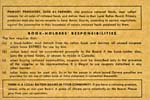Common menu bar links
Institutional links
ARCHIVED - Bon appétit!
A Celebration of Canadian Cookbooks
Archived Content
This archived Web page remains online for reference, research or recordkeeping purposes. This page will not be altered or updated. Web pages that are archived on the Internet are not subject to the Government of Canada Web Standards. As per the Communications Policy of the Government of Canada, you can request alternate formats of this page on the Contact Us page.
History of Canadian Cookbooks
The Culture of Cooking
Preface

Wartime poster, 1914-1918
Food rationing was introduced in Canada on January 24, 1942, as part of the war effort. Its purpose was to limit the use of imported food and to free up supplies for the military and for the allies. First sugar was rationed, then coffee, tea and butter. Everyone was issued a ration book, as well as tokens. Rationing continued, to some degree, until 1947.
During the war years of the 1940s, inexpensive foods became the mainstay of many households. Ground beef was cheap and adaptable, and heart and tongue were common ingredients. Throughout the next two decades, one of Canada's most influential cooks was Kate Aitken. She seemed to be everywhere -- on the radio, in newspapers, directing cooking schools in both Canada and the United States, and advising the government on good nutrition.

Marie Nightingale. Marie Nightingale's Favourite Recipes. Halifax: Nimbus, 1993
"The wonderful sameness of my grandmother's meals -- roast chicken on Sundays, shepherds' pie on Mondays, fish on Fridays, baked beans on Saturdays -- was a reflection of her era" (p. vi). This collection recalls the comfort foods of the 1950s and 1960s, including recipes for favourites such as tuna casserole, banana bread, Scottish shortbread, banana cream pie and Molded Emerald Salad (jellied salads were very popular at the time).








